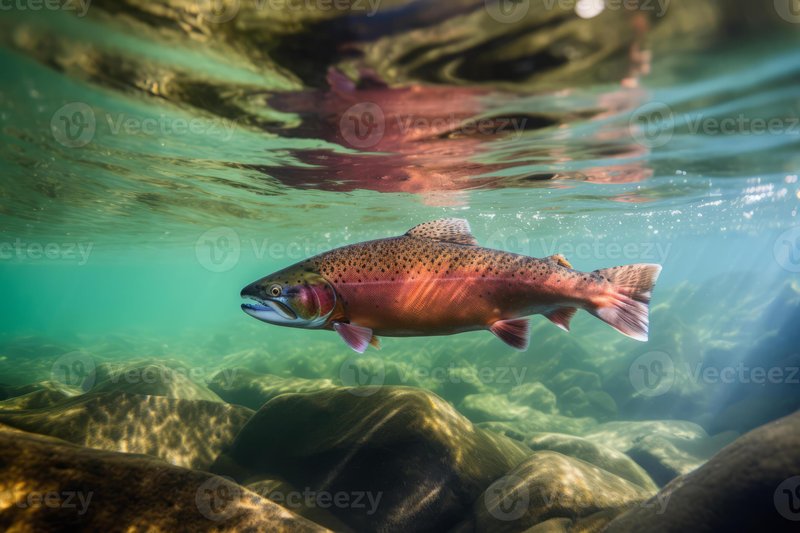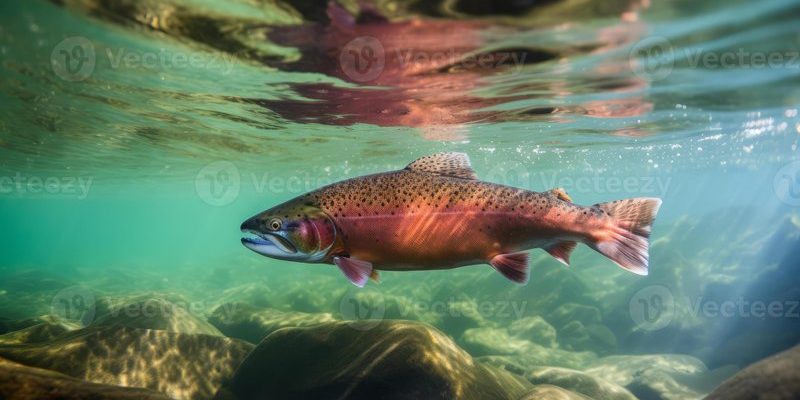
Salmon are known for their impressive migrations. They travel from the ocean to freshwater rivers, sometimes hundreds of miles away, just to spawn. How do they manage this? The secret lies in a blend of sophisticated navigation skills and an extraordinary ability to communicate both with their surroundings and with fellow salmon. Whether it’s sensing the Earth’s magnetic field or picking up chemical cues in the water, salmon are like nature’s little adventurers, equipped with all the tools they need to navigate the watery world around them.
How Salmon Navigate: A Blend of Senses
Salmon have an amazing ability to find their way back to their spawning grounds. They rely on several senses to navigate through vast oceans and rivers. One of the most fascinating methods they use is olfaction, or sense of smell. Salmon can detect specific scents in the water, helping them identify their home river or specific spawning sites. It’s like having a built-in GPS that uses scents instead of maps!
Another key navigation tool for salmon is their ability to sense the Earth’s magnetic field. Recent studies show that salmon have magnetite in their bodies, which helps them detect magnetic fields. This allows them to orient themselves and follow the Earth’s magnetic lines as they travel long distances. Imagine being able to feel the invisible lines on a map; that’s how salmon navigate!
Additionally, salmon also use visual cues from their environment. They can see changes in water clarity and color that signal important information about their surroundings. For instance, when they approach their home river, their eyes recognize familiar landmarks. So, whether they’re sniffing out scents, feeling the magnetic pull of the Earth, or spotting visual clues, salmon are truly skilled navigators!
Communication Through Chemical Signals
Salmon communicate in some surprising ways, and one of the most intriguing is through chemical signals. When salmon enter freshwater to spawn, they release certain chemicals into the water, which can be detected by other salmon. This communication isn’t just about finding mates; it can also signal important information about their environment.
For example, when a salmon is stressed or feels threatened, it can release stress hormones. Other salmon in the area can pick up on these signals and respond appropriately, perhaps by becoming more cautious themselves. It’s like an early warning system in the water! This chemical communication is critical for their survival and helps maintain a balance within their environment.
You might be wondering how significant the impact of these chemical signals really is. Well, imagine walking into a room where someone is upset. You can feel the tension, right? Salmon do something similar in their underwater world; they pick up on these signals and react, which can affect their behavior and even their survival.
Visual and Acoustic Communication
While chemical signals are powerful, salmon also rely heavily on visual and acoustic communication. When swimming together, salmon often display different colors depending on their mood or health. Brightly colored fish are often more appealing to potential mates, while dull colors might indicate they’re stressed or unhealthy.
Moreover, salmon can communicate acoustically, too. They produce different sounds through their swim bladders, which can convey messages to other salmon. These sounds might indicate alarm or distress, helping others in the area to remain alert. It’s like having a chat with friends to let them know something’s up!
Imagine a school of salmon swimming peacefully, and suddenly one starts to panic. The others might see the change in color and hear the alarm call, immediately responding as a group. This combination of visual and auditory cues helps them stay connected and navigate through their journeys safely.
The Role of Social Structure in Salmon Communication
Salmon have complex social structures that contribute to how they communicate. They often travel in schools, which provides safety in numbers. Within these groups, fish can interact and share information. This social structure helps with navigation as they rely on one another for cues and direction.
When salmon are preparing to spawn, their social dynamics change. Adult fish often assert dominance. They might use visual displays, like swimming in a specific way, to establish hierarchy. Understanding their social roles helps them navigate their environment more efficiently, as dominant individuals often lead.
Think of it like a team sport. Just as players rely on each other to win a game, salmon depend on their social networks to thrive in their environment. By working together, they improve their chances of survival and successful reproduction.
The Impact of Environmental Changes on Salmon Navigation
Unfortunately, environmental changes significantly impact how salmon navigate and communicate. Pollution, habitat destruction, and climate change can alter water quality and disrupt the delicate balance of chemical signals. For instance, when rivers are contaminated, it can hinder a salmon’s ability to detect familiar scents, making it harder to find their spawning grounds.
Changes in temperature can also affect their migration patterns. Salmon are sensitive to water temperature, and if it becomes too warm or cold, they may be unable to thrive or find food. This can lead to alterations in their migration routes, forcing them into unfamiliar territory.
Understanding these challenges is vital for conservation efforts. By protecting their habitats and reducing pollution, we can help ensure that salmon continue to navigate and communicate effectively through their environments.
Why Salmon Navigation and Communication Matter
You might wonder why all this information about how salmon navigate and communicate is important. Well, understanding these processes helps us appreciate the delicate balance of ecosystems. Salmon are essential for their aquatic environments, serving as both predators and prey. They also contribute nutrients to river systems when they die after spawning, supporting a host of other wildlife.
By learning about their navigation and communication skills, we can better advocate for their conservation. Healthy salmon populations indicate a thriving ecosystem, while declining numbers signal problems that need urgent attention.
Plus, salmon are culturally significant for many communities. They represent tradition and sustenance, and protecting them ensures that future generations will continue to enjoy their rich history. So, the next time you think of salmon, remember they’re not just fish—they’re vital players in their ecosystems, with navigation and communication skills that make them truly remarkable.
Salmon are extraordinary creatures with fascinating navigation and communication abilities. From sensing scents to feeling magnetic fields, they have an impressive toolkit for finding their way. Their methods of communication through chemical signals, visual cues, and sounds further illustrate their complexity.
As we face environmental challenges that threaten salmon populations, it’s essential to understand their unique skills and the roles they play in our ecosystems. By protecting their habitats and advocating for their survival, we can ensure that these remarkable fish continue to thrive for generations to come. Next time you see salmon in a river or on your plate, you’ll appreciate the incredible journey behind each one, knowing they are much more than just a meal.

